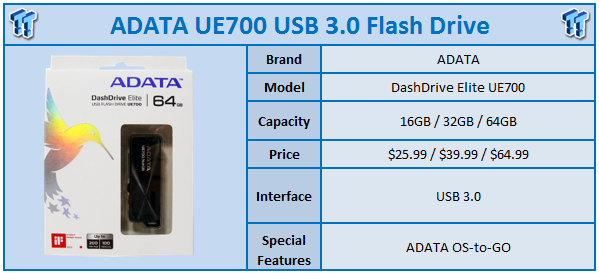
Just a few months back we had the pleasure of looking over ADATA's DashDrive external HDD line-up. Coming away from those articles, I had spoken to ADATA about the possibility of taking a look at some of their unique flash drives and rather quickly they agreed to send over there latest, the DashDrive Elite UE700.
The UE700 USB 3.0 flash drive plays off the "Elite" moniker of the previous DashDrive HE720. Both of the aforementioned drives offer end users a classy, professional storage option with each device sporting a clean exterior consisting of brushed aluminium and the highest quality materials. The UE700 in the 64GB capacity we are looking over today has marketing specifications of 200MB/s read and 100MB/s write and follows the seemingly standard compatibility list of Windows XP, Vista, 7 and 8 along with Mac OS 9+.
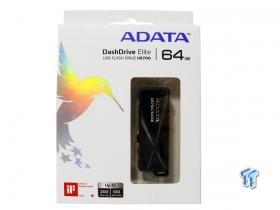
A quick glance over the packaging and it instantly catches your eye with the ADATA bird in a sort of hologram. If that wasn't enough to catch your eye, then ADATA has included a sneak peak at the drive itself. Along the bottom of the packaging we found the "iF product design award" ADATA received just this year, along with marketing specifications listed as well.
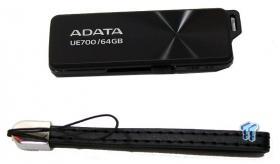
Removing the drive from its packaging, we found the included lanyard to go quite well with the aesthetic appeal of the drive.

The drive itself, while mostly comprised of plastic, has a slice of aluminium along the top to give it that "Elite" feel.
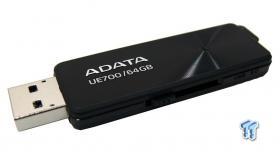
The UE700 uses a unique slide feature that I have yet to see on any other drive - the slide itself is located on the side and has two locking positions.
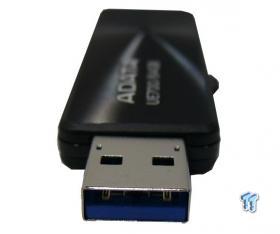
The ADATA UE700 is marketed as a USB 3.0 drive, and as such has its port colored blue to denote this. The drive does maintain backward compatibility with USB 2.0 as well.
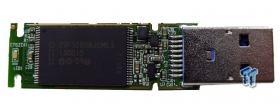
The NAND configuration for the UE700 is set as 2 x 32GB, using Intel 25nm MLC synchronous flash. The ME3 denotes the revision 3 of the NAND.

The flash storage processor used in the UE700 is the new Innostor IS903. We have only seen this controller once before, in the PQI Tiffany where they paired it with Samsung DDR Toggle NAND.
One of the lesser known features of running Microsoft's new operating system Windows 8 is the native capability of USB Attached SCSI or UASP. Benchmarking flash drives, we utilize ATTO Disk Benchmark followed by Crystal Disk Mark. Our last bench incorporates DiskBench and our custom set of real-world data, and is by far the most important comparison when looking for a flash drive for everyday use.
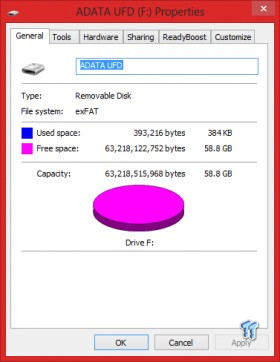
As of late we have seen more manufacturers moving their factory formatting over to exFAT, a move ADATA has made with the UE700. The usable capacity of the DashDrive Elite is set at 58.8GB.
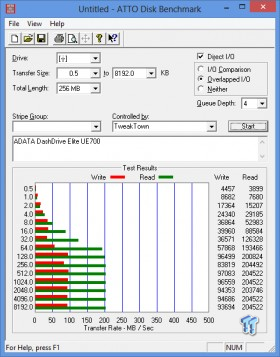
As I stated in the beginning of the article, the UE700 marketing depicts the drive is capable of 200MB/s read and 100MB/s write. In ATTO we found that to be partly true where we achieved 204MB/s in read testing. Write testing fell a bit short at 97MB/s.
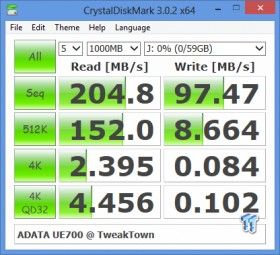
CDM showed similar results where we found the Elite reaching 204MB/s read and 97MB/s write.
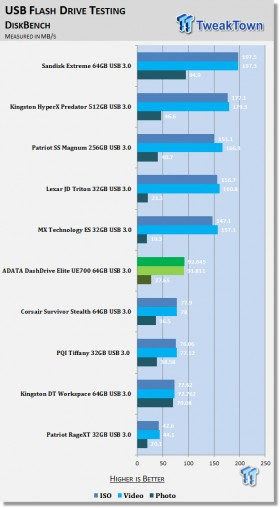
Glancing over our chart we find the ADATA UE700 right in the middle of the pack in terms of real-world performance. This test uses 1000 RAW images, eight MP4 videos and the full 4.7GB Windows 7 ISO.
The Elite UE700 successfully carries on ADATA's approach at creating high-performance drives with a professional appeal. The materials used in this drive offer a compromise between rugged plastics and a sleek aluminium design, both giving the drive an overall sleek appearance add to that a dimly lit blue LED and it just screams how Elite it is.
Performance of the drive was right smack in the middle of our DiskBench chart. While ATTO and CDM both showed the drive capable of 204MB/s read, the drive did suffer a bit in the write speed department, netting just 97MB/s versus the advertised 100MB/s.
Pricing at the time of writing for the 64GB capacity is set at $64.99 making this drive available to you for $1 per GB. Add to this its lifetime warranty and we have what ADATA calls "Neat, Sweet and Complete".
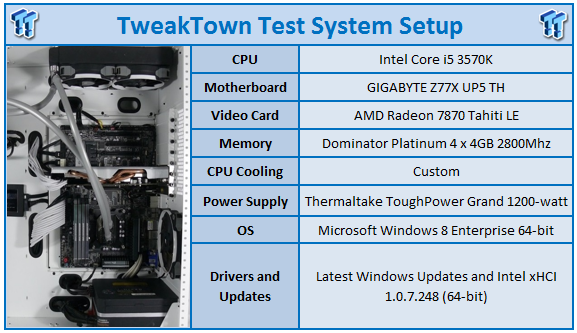



 United
States: Find other tech and computer products like this
over at
United
States: Find other tech and computer products like this
over at  United
Kingdom: Find other tech and computer products like this
over at
United
Kingdom: Find other tech and computer products like this
over at  Australia:
Find other tech and computer products like this over at
Australia:
Find other tech and computer products like this over at  Canada:
Find other tech and computer products like this over at
Canada:
Find other tech and computer products like this over at  Deutschland:
Finde andere Technik- und Computerprodukte wie dieses auf
Deutschland:
Finde andere Technik- und Computerprodukte wie dieses auf